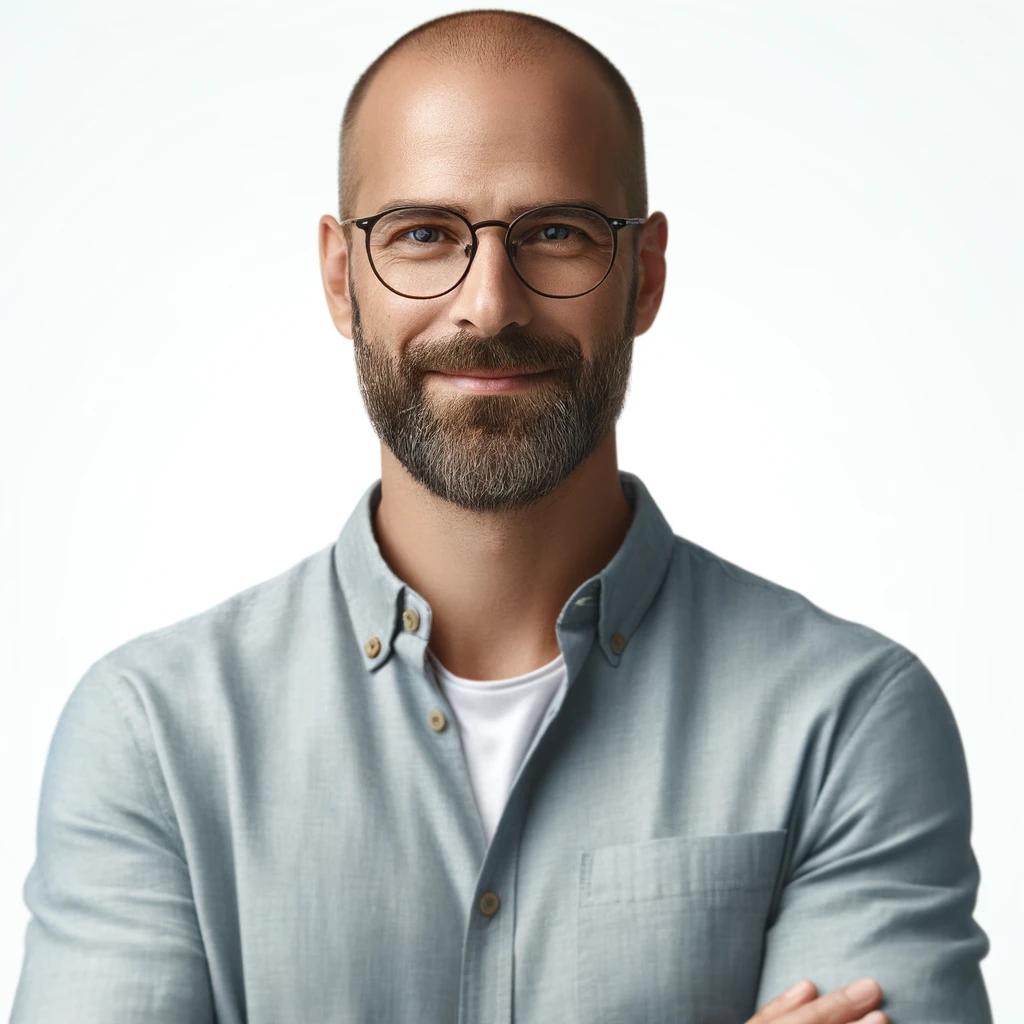HR Chatbot: A Powerful Tool For The Future of HR in 2025?
Updated December 14, 2024
Published June 12, 2023

In the realm of human resource management, HR chatbots have emerged as a significant development. These AI-powered tools are leading a shift in HR practices as artificial intelligence continues to gain popularity across various industries. It may seem ironic, but these HR chatbots have become a game-changer.
HR chatbots offer considerable advantages in various aspects of human resource management. From streamlining recruitment to simplifying onboarding and enhancing performance monitoring, the impact of HR chatbots is transformative.
If you’re intrigued by the potential of HR chatbots, you’ve landed in the right place! This article will delve into the benefits, challenges, and more surrounding HR chatbots. Keep reading to learn more about this transformative technology.
Understanding HR Chatbots
Chatbots have been around in the digital world for a while, but their use in Human Resources (HR) is a fresh trend. Simply put, HR chatbots are software that helps streamline HR tasks through interactive chats. They serve as a digital bridge between HR teams and employees, automating various tasks that would otherwise require human intervention.
While chatbots might remind you of popular AI models like GPT-3, it’s important to note that not all HR chatbots are powered by such advanced AI. However, the potential for integrating large language models (LLMs) like GPT-3 into HR chatbots is promising, as it could significantly enhance their capabilities.
Large Language Models use natural language processing (NLP) to understand and generate text that feels like a human wrote it. Thanks to their training on an enormous dataset, these models have the capability to handle tasks as diverse as generating written content and converting one language into another.
The training these models undergo involves processing a huge volume of data, providing them with the skills needed to accomplish various tasks like creating text or translating between languages. As a result, the application of LLMs in HR chatbots could lead to more natural, efficient, and personalized interactions.
5 Types of Chatbots in HR
The realm of HR chatbots can be broken down into five key types: menu-driven, rule-centered, keyword-responsive, AI-learning, and the blend of these approaches. A brief look at each:
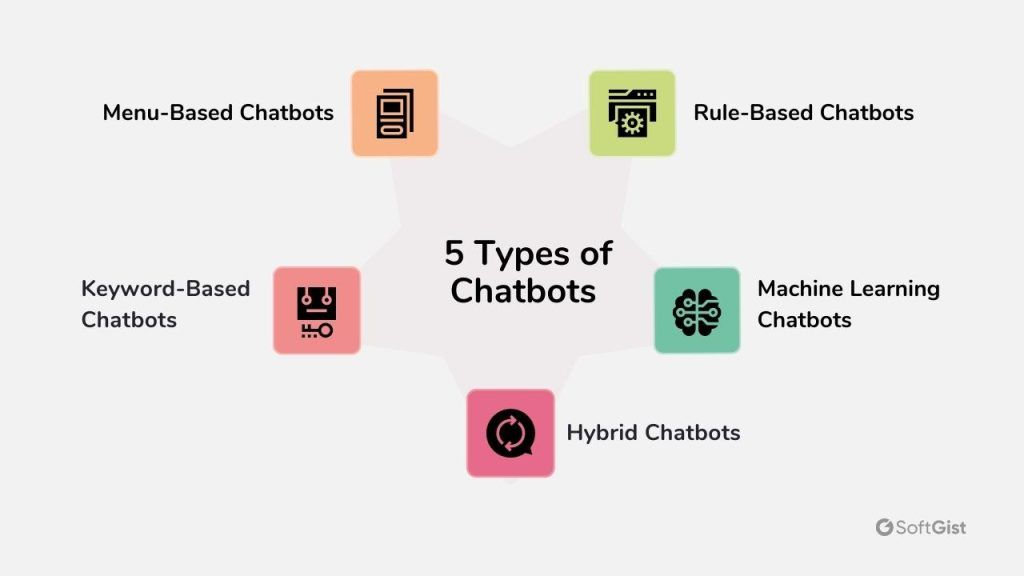
- Menu-based Chatbots: Menu-driven bots are akin to digital assistants, offering users a selection of options and responding as per the user’s choice. They’re useful for answering simple queries and providing standardized responses.
- Rule-based Chatbots: These chatbots interact with users to identify their intent and provide pre-determined responses based on a decision tree. They’re not adaptive but can handle a range of queries.
- Keyword-based Chatbots: These chatbots analyze user inputs for specific keywords or phrases and generate responses accordingly. They’re suitable for slightly more complex queries.
- Machine Learning-based Chatbots: These are AI-powered chatbots that use sophisticated algorithms to handle complex queries. They provide more natural and personalized responses and learn from their interactions.
- Hybrid Chatbots: These chatbots combine the features of the above types to provide a more comprehensive solution.
Related
While the first three types of chatbots are rule-based and follow a set of pre-defined instructions, machine learning-based and hybrid chatbots are more dynamic and can learn from past interactions. This makes them particularly suited to HR tasks, as they can provide personalized support to employees and adapt to the unique needs of an organization.
HR Chatbots: A Specialized Tool
While general-purpose AI models like GPT-3 cater to a broad audience, HR chatbots are specialized tools designed to assist in managing the workforce. They’re trained using relevant HR data, existing knowledge bases, and predefined responses. With the help of natural language processing, they can mimic human-like speech and continually improve their outputs through machine learning.
For example, an AI HR chatbot could be trained to handle common employee queries about leave policies, benefits, and payroll. It could also be programmed to schedule meetings, remind employees about upcoming training sessions, provide 24/7 support, or even assist with onboarding new hires. The possibilities are vast and continue to grow as AI technology advances.
Some software-as-a-service (SaaS) HR chatbot examples include Amber by inFeedo, Amara.ai, and Olivia by Paradox.ai. The key to choosing the right service lies in understanding your specific needs and identifying the SaaS that can best meet them.
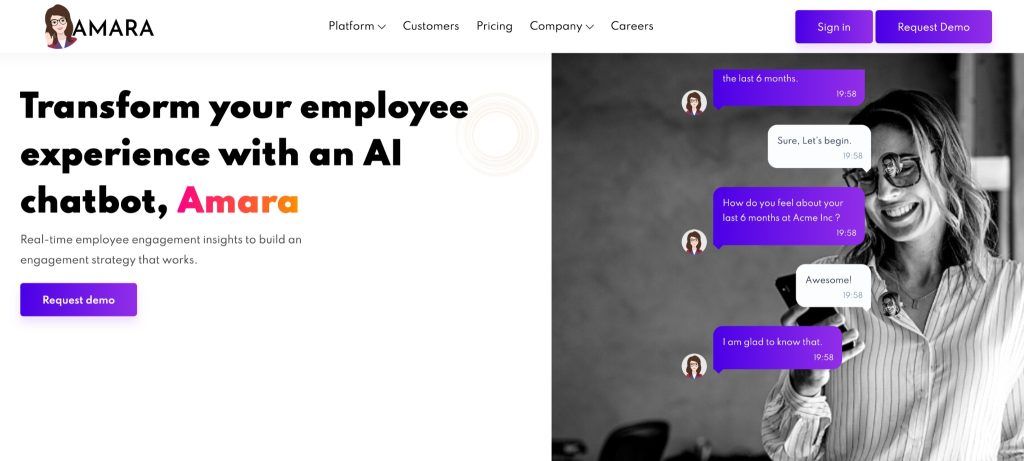
Why Now? The Rise of HR Chatbots
Chatbots and automation technologies have been around for a while, so why are HR departments only now starting to adopt these tools? The answer lies in the convergence of several key factors.
Firstly, recent progress in AI and machine learning has greatly improved chatbot abilities. New AI models like GPT-3 have opened up new uses for chatbots in various areas, including HR. These advanced models enable chatbots to understand and respond to natural language more effectively, making them more useful and user-friendly.
Secondly, the increasing digitalization of HR processes has created a conducive environment for the integration of chatbots. As HR departments move more of their operations online, the use of chatbots to automate routine tasks and provide 24/7 support has become a logical step.
However, the adoption of these technologies in HR is not without its challenges. Data privacy and security are major concerns, as these bots handle sensitive employee information. Moreover, while these bots excel at routine tasks, they may struggle with complex HR issues that require human judgment and empathy.
Despite these challenges, HR chatbots are increasingly being recognized for their potential to streamline HR processes and enhance the employee experience. As AI and machine learning technologies advance, HR chatbots are set to become more sophisticated and crucial to HR functions.
The Benefits of Chatbots in Human Resource Management
The increasing integration of conversational AI in human resource management has sparked curiosity about its potential impact on businesses and industries. As it turns out, chatbots have carved out a significant role in HR departments, offering a host of advantages alongside some challenges. Let’s delve into the expanded benefits of deploying an HR bot in the workplace.

Streamlined HR Processes
HR work can become overwhelming real quick, especially if your workplace has numerous employees. Ironically, it can also turn monotonous, particularly because it involves lots of monitoring, repetitive tasks, documentation, and assistance provision.
A chatbot can help you improve how you perform these functions by automating standardized procedures and answers to queries.
One way that bots streamline HR processes is by automatically monitoring employee performance and providing insights through report generation.
Gone are the days when you need to manually check up on employees to see if they are hitting key performance indicators, how their attendance is, and more.
Because many processes such as candidate evaluation, metric assessments, attendance reporting, shift management, and more are done by AI bots, you can focus on improving your productivity and providing quality assistance to personnel.
In a case study by Paradox, it was revealed that UOB leveraged their AI assistant, Jonus, to revolutionize their recruitment process. Using the AI assistant, UOB cut its time-to-hire by 50% for critical sales roles, increased application-to-offer conversion by 16%, and received a 96% positive experience rating from candidates.

Centralized Access to Information
Access to information is essential to ensure the quality of work from the workforce and that protocols, rules, and guidelines are followed closely. The challenge is keeping everyone in the company informed about updates and changes.
One effective solution to this concern is to integrate a chatbot offering a one-stop access point for all HR-related data.
Imagine an employee who wants to find out how many call-out credits they have left. Instead of asking you so that you can check for them, they can simply enter their question in the chatbot and the AI will provide them with the information they need.
The same goes for matters such as finding out the protocols for filing complaints, providing feedback, and so much more.
Enhanced Employee Experience
Another example of HR chatbot benefits is improved employee experience. As an HR expert, your role involves maintaining your team’s satisfaction, engagement, and participation. This task is no mean feat, especially in large enterprises where employees and HR staff often barely know each other, making trust and connection building a challenge.
HR chatbots help overcome this obstacle by providing a platform where employees can offer insights without worrying about human factors such as bias and judgment.
Moreover, HR managers can also use chatbots to perform surveys to understand employees’ needs, which is essential in creating more favorable work conditions that can in turn lead to higher retention, productivity, and an overall positive work environment.
As an example, Puma used Amber, an engagement HR chatbot from Infeedo.ai to boost employee experience. The bot’s use led to a 91% improvement in experience factors, increased positive sentiment, and more constructive feedback.

Optimized Use of Resources
Investing in an HR chatbot can benefit the entire company by using resources effectively and efficiently. Remember, manpower is a valuable business resource, along with time, skills, talents, and money.
Think about it this way: An AI answering hundreds of questions from 100 employees is more resource-efficient than having a few human personnel answering the same.
In short, chatbots can help improve employee experience and they can do a lot more by helping create a more productive workplace that can cause a wave of impact in different aspects of the business.
Data-Driven Decision Making
HR chatbots serve more than just as communication aids; they’re valuable data reservoirs. Every chatbot-employee interaction can be recorded, scrutinized, and utilized to understand employee behaviors, frequent questions, and potential issues.
For instance, if a policy repeatedly confuses many employees, it could be a signal that the policy needs better clarity. This data-oriented approach empowers HR teams to address concerns proactively, enhance HR policies, and make informed decisions to elevate HR management efficiency.
Employee Training and Development
HR chatbots can also be a game-changer in employee training and development. These bots can be coded to offer instant responses to training material inquiries, schedule training, and even deliver interactive learning sessions.
Imagine a bot guiding an employee through new software, offering step-by-step guidance and answering questions instantly. Not only does this streamline the training process, but it also allows for tailored learning experiences, fostering employee performance and productivity.
Scalability
One of the standout benefits of HR chatbots is their scalability. As organizations grow, the volume of HR tasks and queries can increase exponentially. HR teams, no matter how efficient, have limits to the number of tasks they can handle at once.
Chatbots, however, can easily scale to handle more queries, ensuring all employees receive timely and consistent support. This scalability makes chatbots a sustainable and cost-effective solution for HR management in growing organizations.
Clearly, chatbots do more than just enhance the employee experience. They aid in fostering a more productive workplace, causing positive effects on various business aspects. However, it’s important to remember that they are tools designed to assist human HR professionals, not replace them. However, the human touch still holds its significance in HR management, especially when dealing with complex employee issues, making strategic choices, and nurturing a positive work culture.
Use Cases for HR Chatbots
What you need to know is that these smart bots have made remarkable changes in how businesses communicate with their workforce, while making HR-related functions more efficient and effective.
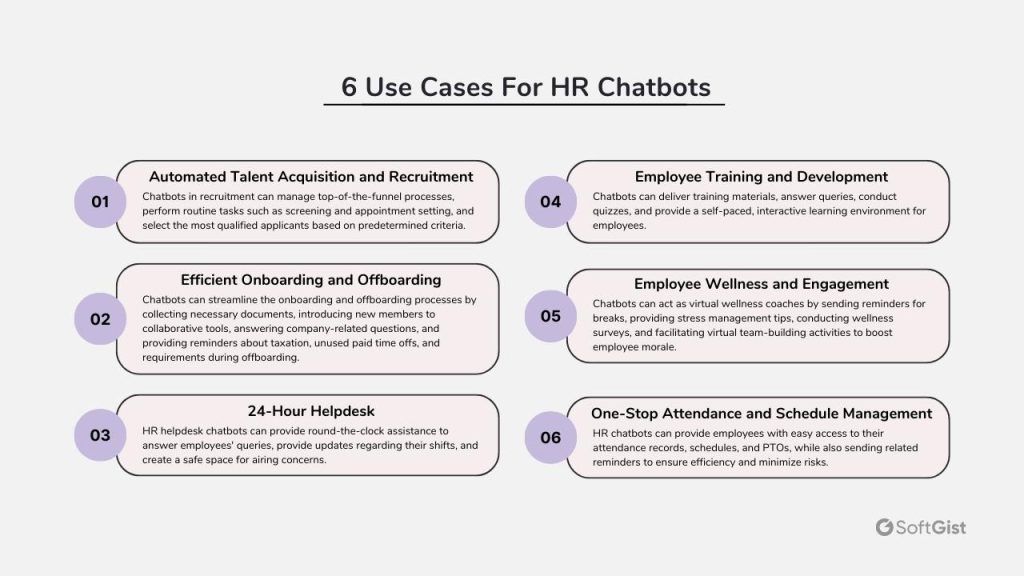
The extent of their impact depends on how they are used in a specific workplace. Here are some of the best chatbot HR use cases.
Automated Talent Acquisition and Recruitment
If you’ve recently applied for jobs or are an HR manager yourself, you have probably encountered the use of chatbots in talent acquisition and recruitment.
Companies typically use chatbots in recruitment for top-of-the-funnel processes up to the point where human action is required. With these AI tools, your candidates can start their application by prompting a recruitment-focused chatbot, then proceed by inputting the requested details.
One thing you should note is that these bots use a set of predetermined standards that compares information entered by candidates against relevant criteria such as educational background, work experience, and skillsets to select the most qualified applicants.
An example of an HR chatbot is Olivia by Paradox.ai, a conversational AI that can serve as a candidate’s initial contact point or as your recruitment assistant. It can perform routine tasks such as screening, appointment setting, reminders, and more.
Aside from Olivia, there are other AI assistants for recruitment. Other uses of chatbots in this talent acquisition stage include serving as an automated assistant that answers frequently asked questions,
Efficient Onboarding and Offboarding
Besides screening talents and applicants, companies also use AI in onboarding and offboarding processes.
Successful candidates no longer need to physically submit the required documents and other onboarding materials. Instead, HR departments deploy a chatbot that prompts new employees to upload these files in a conversation format.
These tools are also used to welcome new team members, add them to collaborative tools, provide essential information, answer company-related questions, and even help in initial training.
iSolved’s People Cloud excellently demonstrates this use case. As a conversational virtual assistant, you can use People Cloud to invite and introduce new members to Microsoft Teams where they can interact with other employees and the AI assistant.
In a customer story from Workato, Broadcom leveraged Workato’s automation platform to streamline its onboarding process amidst multiple acquisitions, as shared in a Workato customer story. The automation significantly reduced VPN setup and email provisioning times, enhancing new hire productivity and saving considerable time.
Bots also aid in offboarding by providing automatic reminders about important information such as taxation, unused paid time offs (PTOs), and requirements. They also initiate automated actions that can help with the graceful transition for both the company and the employee.
24-Hour Helpdesk
One thing about employee support, especially in companies with shifting schedules, is that HR personnel may not be able to assist at all times. This may seem like a minor issue, but it can lead to great delays in service provision and operations.
Imagine shooting your HR staff for an urgent concern only to receive a response after the whole thing is over. This can be frustrating and can impact your performance. Chatbots are the simple solution to this problem. An HR helpdesk chatbot can serve as a virtual assistant that can answer questions without taking a break.
As a real-world example, Workflow automation platform Workato offers a service desk chatbot that streamlines internal communications, effectively manages tickets, and improves user experiences, while ensuring round-the-clock availability.
Moreover, the best HR chatbots not only provide standardized information but can also offer employees updates regarding their shifts, attendance, and leave credits. It can also create a safe space where the staff can air their concerns.
Employee Training and Development
HR chatbots can also play a significant role in employee training and development. They can be programmed to deliver training materials, answer queries, and even conduct quizzes to assess the understanding of the employees.
This not only makes the training process more interactive but also allows for self-paced learning. Employees can access the training materials and seek clarifications at any time, enhancing the overall learning experience.
Employee Wellness and Engagement
In the era of remote work and digital workplaces, maintaining employee wellness and engagement has become more challenging than ever. HR chatbots can help address this issue by acting as virtual wellness coaches.
They can send reminders for breaks, provide tips for stress management, and even conduct quick wellness surveys. Furthermore, they can also facilitate virtual team-building activities and recognition programs, thereby fostering a sense of community and boosting employee morale.
For example, Amara, an AI chatbot, serves as a friend to employees and a tool for HR. It identifies disengaged employees, personalizes interactions, and offers actionable insights on employee sentiments, enhancing overall engagement.
One-Stop Attendance and Schedule Management
Employees are definitely expected to keep track of their attendance, schedules, and PTOs but let’s be honest, people are not always in the right head space to promptly take note of these details.
Conversational AI in HR can help minimize the issues that come with this by giving your people a way to check their standing without worries. With this, they can get such information anytime, anywhere.
You can also use an HR support chatbot to send attendance- and schedule-related reminders that can reduce risks and inefficiencies.
Strategies for Successful HR Chatbot Implementation
Implementing HR chatbots can be a game-changer for your organization, but it’s not without its challenges. Here are eight strategies to ensure a successful implementation, while addressing potential hurdles:

Define Your Objectives
Start by outlining your goals. A detailed list of objectives can guide you towards the right chatbot service and vendor. Your objectives should align with your business goals and the unique needs of your HR department.
Don’t Overload on Features
While it’s tempting to choose a chatbot with all the fancy features, focus on the ones that align with your HR objectives. Avoid paying for features you won’t use, as this can lead to unnecessary costs and potentially compromise usability.
Prioritize Adaptability and Scalability
Your organization may grow, and your chatbot should be able to grow with it. Look for a chatbot that offers customization options and smart adaptive learning capabilities. This will allow it to adapt to new situations and learn from past interactions.
Ensure Compliant Security and Privacy Features
Security and privacy are paramount when implementing HR chatbots. Ensure your chosen chatbot complies with data privacy legislation in the countries where you operate. Be aware that third-party vendors can introduce potential security risks, so choose a vendor with a strong track record in cybersecurity.
Pick a Reputable Vendor
The product is only as good as its vendor. Choose a vendor known for excellence in AI, machine learning, and language models. They should provide excellent customer service and have a solid strategy for addressing issues and managing risks.
Consider the Interface and Usability
Usability is the key to a chatbot’s effectiveness. Opt for a chatbot that offers a user-friendly interface, easy to use, access, and comprehend.
Incorporate Employee Training
A new chatbot can be a significant change for your employees. To ensure a smooth transition, provide comprehensive training on how to use the chatbot. This can include live demonstrations, tutorials, or even a dedicated support team to answer any questions.
Plan for Continuous Improvement
The implementation of your HR chatbot is not a one-time event, but an ongoing process. Regularly review the performance of your chatbot and seek feedback from users. This information should be leveraged for continual enhancements, ensuring your chatbot remains a vital HR tool.
Bear in mind, while chatbots can simplify and expedite HR tasks, they come with their limitations. They may not be able to handle unique HR-related circumstances that require human judgment. Over-reliance on chatbots can negatively impact your workflow and quality of support. Therefore, it’s important to strike a balance between human and AI interactions in your HR processes. Also check out our guide here for more tips on how to choose the right chatbot for your needs.
Emerging Trends in HR Chatbot Implementation
As we delve deeper into the digital era, HR chatbots are progressively evolving, offering advanced solutions to streamline HR procedures. Here are a few trends shaping the future of HR chatbots:
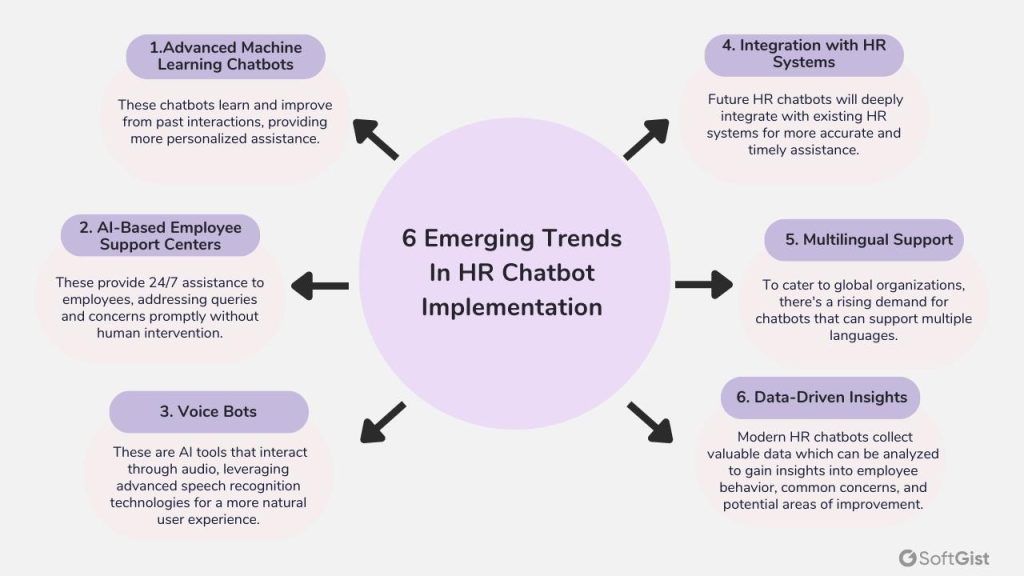
Advanced Machine Learning Chatbots
The future of HR chatbots lies in advanced machine learning models. These AI-fueled bots can learn from past interactions, enhancing their responses over time. This allows them to deliver more precise and personalized assistance to employees. The upcoming release of an open-source language model from ChatGPT creators is a prime example of this trend.
AI-Based Employee Support Centers
Another emerging trend is the development of AI-based support centers for employees. These platforms can provide 24/7 assistance to employees, addressing common queries and concerns without the need for human intervention. This not only improves efficiency but also enhances the employee experience by providing immediate support.
Voice Bots
While text-based chatbots are still prevalent, a trend is growing towards voice bots in HR. These AI tools interact with users through audio, offering a more natural and intuitive user experience. They leverage advanced speech recognition and synthesis technologies to understand and respond to voice commands.
Integration with HR Systems
The future of HR chatbots also involves deeper integration with existing HR systems. This allows the chatbots to tap into real-time data, enabling them to provide more precise and timely help. For example, a chatbot integrated with a company’s leave management system can instantly update an employee on their remaining leave balance.
Multilingual Support
With the rise of global organizations, there’s a growing need for HR chatbots that can support multiple languages. This allows employees from different regions to interact with the chatbot in their preferred language, improving accessibility and user satisfaction.
Data-Driven Insights
Modern HR chatbots are not just about providing assistance. They also collect valuable data from their interactions with employees. This data can be analyzed to gain insights into employee behavior, common concerns, and areas of improvement. This helps HR departments make more informed decisions and improve their services.
These trends underscore the potential of HR chatbots to transform the way HR departments operate. By staying up-to-date with these trends, HR professionals can leverage the latest technologies to enhance their services and provide a better experience for their employees.
Final Thoughts
The rise of chatbots in HR is transforming industries worldwide, making them a strategic move for companies of all sizes. By streamlining HR processes and enhancing employee experience, these AI tools are becoming a competitive advantage. However, their successful implementation requires careful planning and a commitment to continuous improvement.
With the emergence of machine-learning chatbots and voice bots, the future of HR processes is set to be even more efficient. Embrace this technology and give your HR processes a digital boost – it could be the key to a more productive and engaged workforce.
Share This Post
Alex Powell
Alex Powell is a senior tech and business media writer with a passion for breaking down complex tech topics into easy-to-understand information. He holds a degree in Business Administration and a master's in Journalism. When he's not writing, Alex enjoys hiking and reading books.
Allow cookies
This website uses cookies to enhance the user experience and for essential analytics purposes. By continuing to use the site, you agree to our use of cookies.
